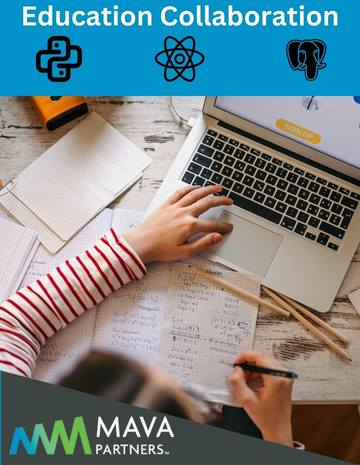EDUCATION COLLABORATION PLATFORM
Category
E-learning / Collaboration Portal
Overview
An educational institution needed a modern platform to enable real-time collaboration between teachers and students. Existing tools were fragmented—one system for assignments, another for lectures, and yet another for discussions—leading to confusion and low adoption rates.

How the Problem Was Solved
Technology Stack:
- Backend: Python (Django) or Node.js (Express) for managing user profiles, courses, and assignments
- Frontend: React or Angular for a dynamic, user-friendly interface
- Database: PostgreSQL or MongoDB for storing course content, user data, and discussion threads
- Real-time Communication: WebSockets / Socket.IO for live chat and classroom sessions
Key Features:
- Unified Course Management: Teachers can create, schedule, and manage all course materials in one place.
- Live Virtual Classrooms: Real-time video conferencing, whiteboard functionality, and breakout rooms for group work.
- Assignment Submission & Grading: Automated workflows for students to submit assignments, with grading rubrics and immediate feedback loops.
- Discussion Forums: Persistent message boards, Q&A threads, and peer review capabilities.
Approach:
- Modular Design: Course, assignment, discussion, and live-session modules could be developed and updated independently.
- Focus on User Experience: Conducted user testing with teachers and students to ensure intuitive navigation and minimal friction.
- Scalable Architecture: Cloud-based hosting with containerization (Docker/Kubernetes) to handle sudden spikes (e.g., exam times).
The Results
Impact on the Business:
- Increased Engagement: Student-teacher interaction rose by 40% due to consolidated communication channels.
- Reduced Admin Overhead: Automated grading workflows and consolidated analytics freed up staff resources.
- Enhanced Learning Outcomes: Real-time feedback improved student performance and reduced turnaround time for queries.
Cost:
- ~75K USD
- Moderate ongoing subscription for video conferencing and cloud hosting services.
Time:
- 6-9 months from prototype to full deployment, followed by incremental enhancements in quarterly releases.
Lessons Learned
- What Went Well:
- Early pilot testing with a small group of teachers helped refine the platform’s most crucial features.
- Integrated single sign-on (SSO) streamlined user management across the institution’s other systems.
- What We Would Do Differently Next Time
- Invest more in an onboarding and training program to ensure teachers and students maximize platform capabilities.
- Introduce more analytics dashboards early on, giving educators insights into student engagement and performance trends.
